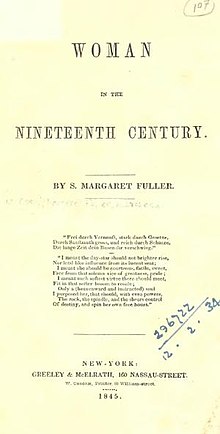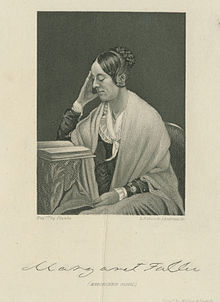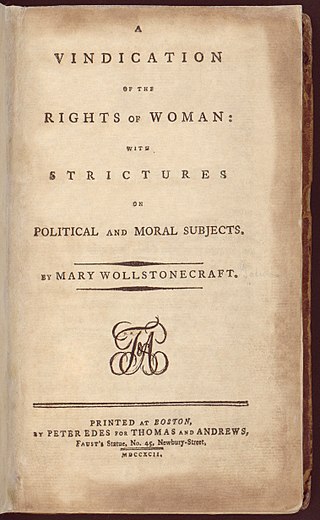
A Vindication of the Rights of Woman: with Strictures on Political and Moral Subjects (1792), written by British philosopher and women's rights advocate Mary Wollstonecraft (1759–1797), is one of the earliest works of feminist philosophy. In it, Wollstonecraft responds to those educational and political theorists of the eighteenth century who did not believe women should receive a rational education. She argues that women ought to have an education commensurate with their position in society, claiming that women are essential to the nation because they educate its children and because they could be "companions" to their husbands, rather than mere wives. Instead of viewing women as ornaments to society or property to be traded in marriage, Wollstonecraft maintains that they are human beings deserving of the same fundamental rights as men.

Ralph Waldo Emerson, who went by his middle name Waldo, was an American essayist, lecturer, philosopher, abolitionist, and poet, who led the transcendentalist movement of the mid-19th century. He was seen as a champion of individualism and critical thinking, as well as a prescient critic of the countervailing pressures of society and conformity. Friedrich Nietzsche considered him "the most gifted of the Americans", and Walt Whitman referred to him as his "master".
Transcendentalism is a philosophical, spiritual, and literary movement that developed in the late 1820s and 1830s in the New England region of the United States. A core belief is in the inherent goodness of people and nature, and while society and its institutions have corrupted the purity of the individual, people are at their best when truly "self-reliant" and independent. Transcendentalists saw divine experience inherent in the everyday, rather than believing in a distant heaven. Transcendentalists saw physical and spiritual phenomena as part of dynamic processes rather than discrete entities.

Elizabeth Palmer Peabody was an American educator who opened the first English-language kindergarten in the United States. Long before most educators, Peabody embraced the premise that children's play has intrinsic developmental and educational value.

Sarah Margaret Fuller, sometimes referred to as Margaret Fuller Ossoli, was an American journalist, editor, critic, translator, and women's rights advocate associated with the American transcendentalism movement. She was the first American female war correspondent and full-time book reviewer in journalism. Her book Woman in the Nineteenth Century is considered the first major feminist work in the United States.

Sarah Josepha Buell Hale was an American writer, activist, and editor of the most widely circulated magazine in the period before the Civil War, Godey's Lady's Book. She was the author of the nursery rhyme "Mary Had a Little Lamb". Hale famously campaigned for the creation of the American holiday known as Thanksgiving, and for the completion of the Bunker Hill Monument.

Frances Ellen Watkins Harper was an American abolitionist, suffragist, poet, temperance activist, teacher, public speaker, and writer. Beginning in 1845, she was one of the first African-American women to be published in the United States.
The Transcendental Club was a group of New England authors, philosophers, socialists, politicians and intellectuals of the early-to-mid-19th century which gave rise to Transcendentalism.
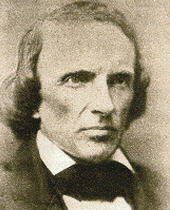
William Henry Channing was an American Unitarian clergyman, writer and philosopher.

James Freeman Clarke was an American minister, theologian and author.

The Margaret Fuller House was the birthplace and childhood home of American transcendentalist Margaret Fuller (1810–1850). It is located at 71 Cherry Street, in the Old Cambridgeport Historic District area of Cambridge, Massachusetts, in the neighborhood now called "The Port". The house is now a National Historic Landmark.

Margaret Ives Abbott was an American amateur golfer. She was the first American woman to win an Olympic event: the women's golf tournament at the 1900 Summer Olympics.
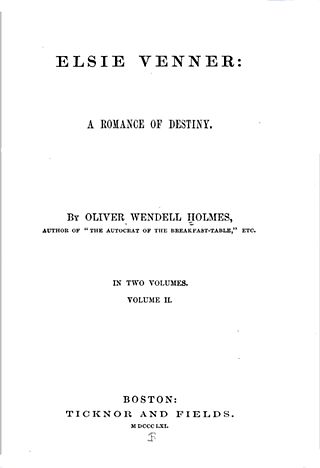
Elsie Venner: A Romance of Destiny is an 1861 novel by American author and physician Oliver Wendell Holmes, Sr. Later dubbed the first of his "medicated novels", it tells the story of a young woman whose mother was bitten by a rattlesnake while pregnant, which imbued the child with some characteristics of the reptile. Bernard Langdon, who takes a teaching job at Elsie's school, becomes curious about her, even as he slightly fears her.
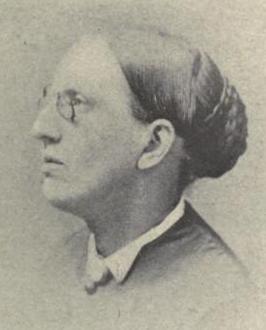
Caroline Wells Dall was an American feminist writer, transcendentalist, and reformer. She was affiliated with the National Women's Rights Convention, the New England Women's Club, and the American Social Science Association. Her associates included Elizabeth Peabody and Margaret Fuller, as well as members of the Transcendentalist movement in Boston.
The eternal feminine, a concept first introduced by Johann Wolfgang von Goethe in his play Faust (1832), is a transcendental ideality of the feminine or womanly abstracted from the attributes, traits and behaviors of a large number of women and female figures. In Faust, these include historical, fictional, and mythological women, goddesses, and even female personifications of abstract qualities such as wisdom. As an ideal, the eternal feminine has an ethical component, which means that not all women contribute to it. Those who, for example, spread malicious gossip about other women or even just conform slavishly to their society's conventions are by definition non-contributors. Since the eternal feminine appears without explanation only in the last two lines of the play, it is left to the reader to work out which traits and behaviors it involves and which of the various women and female figures in the play contribute them. On these matters Goethe scholars have achieved a certain degree of consensus. The eternal feminine also has societal, cosmic and metaphysical dimensions.
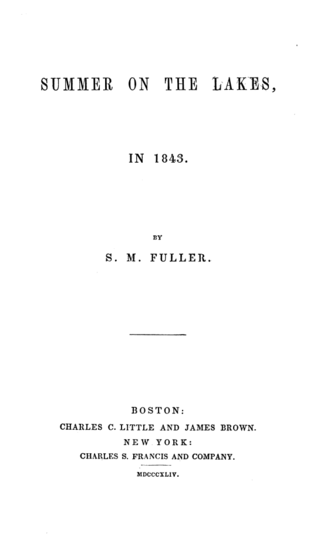
Summer on the Lakes, in 1843 is a nonfiction book by American writer and transcendentalist Margaret Fuller based on her experiences traveling to the Great Lakes region.

Samuel Gray Ward was an American poet, author, and minor member of the Transcendentalism movement. He was also a banker and a co-founder of the Metropolitan Museum of Art. Among his circle of contemporaries were poets and writers such as Ralph Waldo Emerson and Margaret Fuller who were deeply disappointed when Ward gave up a career in writing for business just before he married.
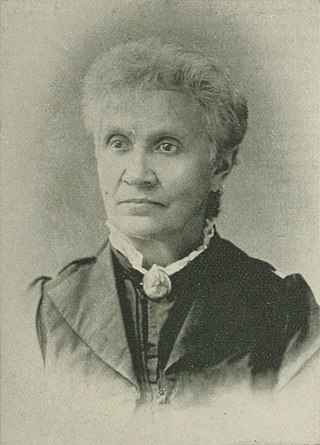
Lucinda Chandler was an American social reformer and author of the long nineteenth century. She was a leader in the social purity movement. She was affiliated with Elizabeth Boynton Harbert.

Caroline Sturgis Tappan, commonly known as Caroline Sturgis, or "Cary" Sturgis, was an American Transcendentalist poet and artist. She is particularly known for her friendships and frequent correspondences with prominent American Transcendentalists, such as Margaret Fuller and Ralph Waldo Emerson. Sturgis published 25 poems in four different volumes of The Dial, a Transcendental periodical. She also wrote and illustrated two books for children, Rainbows for Children (1847) and The Magician’s Show Box, and Other Stories (1856).
